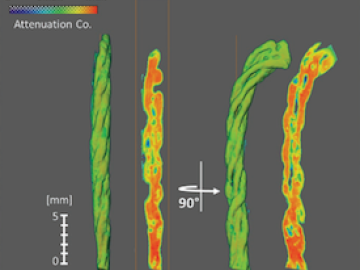
Filter News
Area of Research
- (-) Energy Science (53)
- (-) Neutron Science (125)
- (-) Quantum information Science (2)
- Advanced Manufacturing (6)
- Biological Systems (1)
- Biology and Environment (49)
- Computational Biology (2)
- Computational Engineering (2)
- Computer Science (6)
- Electricity and Smart Grid (1)
- Functional Materials for Energy (1)
- Fusion and Fission (4)
- Fusion Energy (1)
- Isotopes (6)
- Materials (77)
- Materials for Computing (11)
- National Security (20)
- Nuclear Science and Technology (10)
- Supercomputing (81)
News Topics
- (-) Big Data (7)
- (-) Biomedical (20)
- (-) Composites (18)
- (-) Machine Learning (10)
- (-) Microscopy (11)
- (-) Molten Salt (1)
- (-) Neutron Science (121)
- (-) Summit (9)
- 3-D Printing/Advanced Manufacturing (83)
- Advanced Reactors (6)
- Artificial Intelligence (14)
- Bioenergy (31)
- Biology (18)
- Biotechnology (5)
- Buildings (38)
- Chemical Sciences (17)
- Clean Water (10)
- Computer Science (41)
- Coronavirus (22)
- Critical Materials (9)
- Cybersecurity (11)
- Energy Storage (74)
- Environment (59)
- Exascale Computing (2)
- Fossil Energy (3)
- Frontier (3)
- Fusion (2)
- Grid (40)
- High-Performance Computing (8)
- Hydropower (3)
- Isotopes (1)
- Materials (46)
- Materials Science (48)
- Mathematics (3)
- Mercury (3)
- Microelectronics (1)
- Nanotechnology (18)
- National Security (7)
- Nuclear Energy (9)
- Partnerships (12)
- Physics (11)
- Polymers (12)
- Quantum Computing (1)
- Quantum Science (16)
- Security (8)
- Simulation (4)
- Space Exploration (6)
- Statistics (1)
- Transportation (68)
Media Contacts

While studying how bio-inspired materials might inform the design of next-generation computers, scientists at ORNL achieved a first-of-its-kind result that could have big implications for both edge computing and human health.

Oak Ridge National Laboratory scientists designed a recyclable polymer for carbon-fiber composites to enable circular manufacturing of parts that boost energy efficiency in automotive, wind power and aerospace applications.

Neutron scattering techniques were used as part of a study of a novel nanoreactor material that grows crystalline hydrogen clathrates, or HCs, capable of storing hydrogen.

Researchers at the Department of Energy’s Oak Ridge National Laboratory and their technologies have received seven 2022 R&D 100 Awards, plus special recognition for a battery-related green technology product.

Scientists at ORNL used neutron scattering to determine whether a specific material’s atomic structure could host a novel state of matter called a spiral spin liquid.

To solve a long-standing puzzle about how long a neutron can “live” outside an atomic nucleus, physicists entertained a wild but testable theory positing the existence of a right-handed version of our left-handed universe.

ORNL scientists will present new technologies available for licensing during the annual Technology Innovation Showcase. The event is 9 a.m. to 3 p.m. Thursday, June 16, at the Manufacturing Demonstration Facility at ORNL’s Hardin Valley campus.

ORNL researchers used the nation’s fastest supercomputer to map the molecular vibrations of an important but little-studied uranium compound produced during the nuclear fuel cycle for results that could lead to a cleaner, safer world.

From helping 750 million viewers watch Princess Diana’s wedding to enabling individual neutron scientists observe subatomic events, Graeme Murdoch has helped engineer some of the world’s grandest sights and most exciting scientific discoveries.

Textile engineering researchers from North Carolina State University used neutrons at Oak Ridge National Laboratory to identify a special wicking mechanism in a type of cotton yarn that allows the fibers to control the flow of liquid across certain strands.


